Episode #365: How to Support All Students Without ‘Watering Down’ the Math: A Look At MTSS
LISTEN NOW HERE…
WATCH NOW…
Why Your Struggling Students Aren’t Catching Up—Even With Extra Help
In this episode, we take a closer look at MTSS—Multi-Tiered System of Supports—through the lens of mathematics. While many schools have a clearer vision of what MTSS looks like in literacy, applying the same structure in math can be more complex. We unpack what Tier 1, Tier 2, and Tier 3 supports mean in a math context, examine the differences between math and literacy intervention models, and explore what current research says about effective practices. From the importance of strong core instruction to the challenges of designing meaningful interventions, we explore how educators can build a math support system that truly works for all students.
Key Takeaways:
- understand how each tier of MTSS translates to the math classroom.
- reflect on the differences between math and literacy interventions and why a one-size-fits-all approach doesn’t work.
- learn what research recommends for effective math support at each tier.
- recognize the importance of strong Tier 1 instruction as the foundation for all students.
- leave with practical considerations for designing responsive, aligned math interventions that go beyond pull-out support.
Attention District Math Leaders:
How To Teach Algebra: A Course on Conceptual Understanding
Not sure what matters most when designing math improvement plans? Take this assessment and get a free customized report: https://makemathmoments.com/grow/
Ready to design your math improvement plan with guidance, support and using structure? Learn how to follow our 4 stage process. https://growyourmathprogram.com
Looking to supplement your curriculum with problem based lessons and units? Make Math Moments Problem Based Lessons & Units
Be Our Next Podcast Guest!
Join as an Interview Guest or on a Mentoring Moment Call
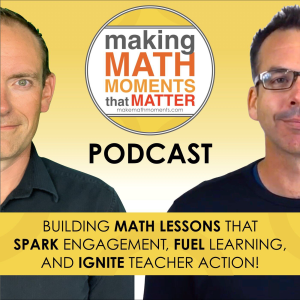
Apply to be a Featured Interview Guest
Book a Mentoring Moment Coaching Call
Are You an Official Math Moment Maker?
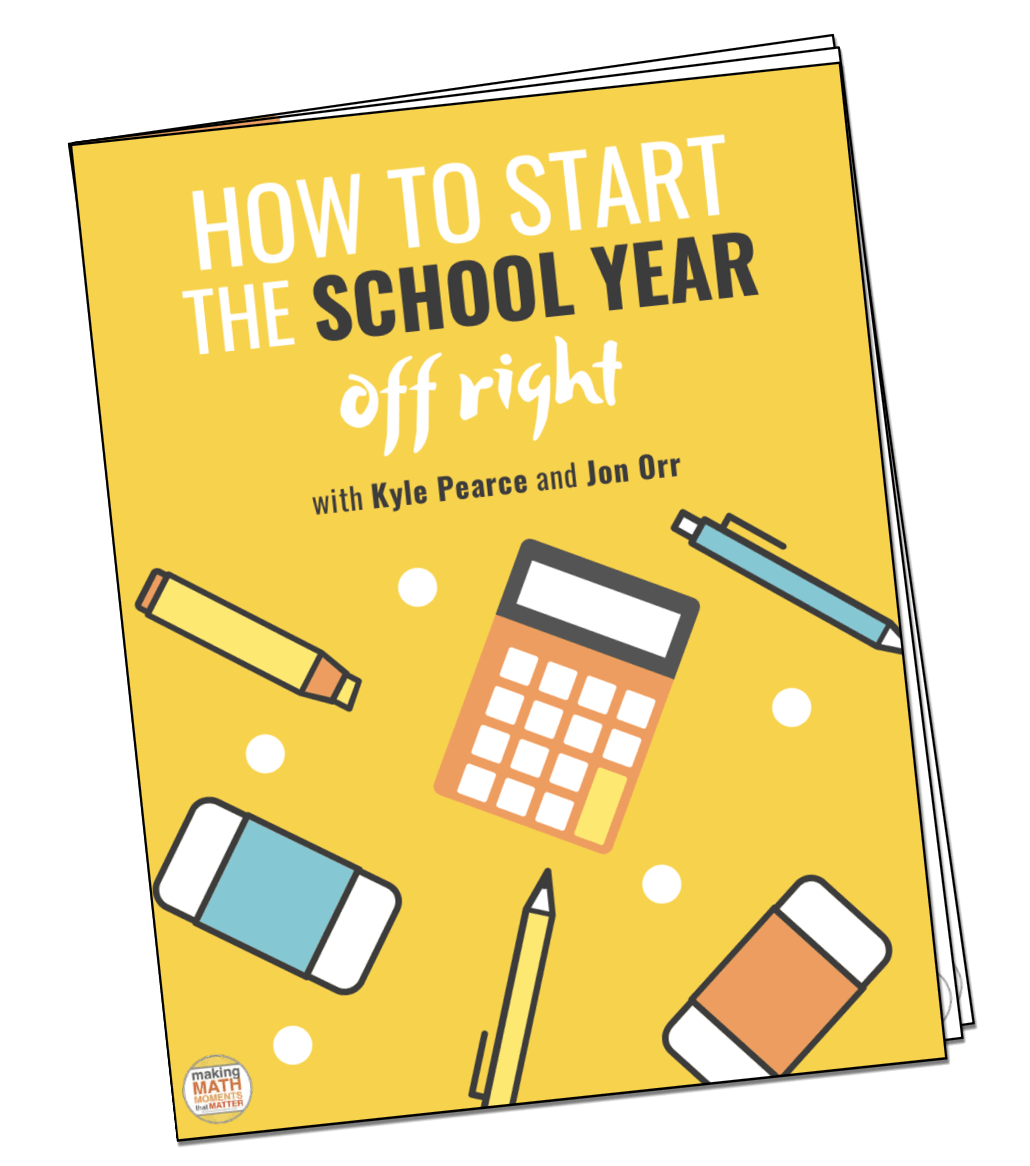
FULL TRANSCRIPT
Yvette Lehman: Alright John, today we are talking about what I would argue is like a hot topic. I hear about it a lot, both in the world of literacy and math, and it’s really looking at the MTSS structure, so the multi-tiered system for support or support system. And I think that anybody who lives in the world of both math and literacy, you know, in literacy this is commonly adopted. And what we’re trying to see happen in a lot of districts right now is apply the same principles to math instruction.
And I think that probably a lot of people are facing some challenges when it comes to the implementation of the multi-tier support system in math. And that’s with good reason. And that’s really just because the research is not nearly as mature. Like you’re in the science of reading world, you’re talking about 50 years of meta analysis of research. And, you know, it’s just been around a lot longer where I would say the research around tiers of intervention in math is in kind of its infancy. So it’s not really a surprise that districts are grappling with how to implement this or find parallels between the work that they’re doing in literacy.
Jon Orr: Sure, sure. makes sense. you know, think, I think just literacy in general has been, more of a lot, like you’re saying, long term focus for, our society as say, then being say math literate or having say, solid number sense. And I think we are, we are seeing that uptick in the last decade in terms of mathematics versus literacy and the, and the changes that we’ve been, you know, seeing we’ve been, we’ve been helping implement.
So yeah, makes a lot of sense that, you know, the research isn’t there yet. The implementation isn’t there yet, but you’re right. Like we are hearing more and more about it. The districts that we’re talking with on a regular basis are saying, we want to make this more of our, more of a plan for support for, for students. know, you’ve heard us talk about, you know, multi-tier support systems throughout the last few years on the podcast. Anytime you hear us saying tier one, tier two, tier three, that’s what we’re talking about. So if you’re like, Hey, I,
I’ve also heard of MTSS, but I don’t really know what we’re talking about. That’s what we’re going to dig in here today.
Yvette Lehman: And I just want to start by maybe looking at why math is perhaps a little bit more complex than literacy. So for anybody listening who lives kind of with one foot in both of these worlds, and I mean, you have a foot in this world as well, John, because of what Scarlett does. you know, I know John’s wife does a lot of work and is an expert in early reading development and providing tiers of support for striving readers. And so one thing that we know
I think with more clarity about literacy is that the research actually suggests in literacy that you can teach skills in isolation. And what I mean by that, anybody who wants to dig into the research, like if you’re really keen to do this, Scarborough’s reading rope talks about how early reading development is separated into essentially two sides of a rope, kind of like our proficiencies rope. But what they say is that early on when students are emergent readers, they actually suggest that you keep those sides of the rope separate.
And the top half is your big kind of cognitively demanding skills like comprehension. So it’s your schema, your background knowledge, your vocabulary, your literary knowledge. It’s your exposure to the world and exposure to text features. But in the bottom half is your foundational skills. And these skills can be taught really explicitly and really systematically and sequentially. And because the alphabet is a man-made construct,
There’s like a really well researched proven roadmap to teach these skills to reach fluency where students can pull the words from the page and spell the words correctly following the English language alphabet. basically in the literacy world, there are some really well developed screeners and diagnostics to be able to pinpoint exactly where a student is along this learning trajectory. And then there’s research on high impact strategies to intervene.
Where I think math is a lot more complex, similar to language comprehension in literacy, is that the research suggests that in math skills taught in isolation aren’t super helpful. Because math is so interconnected and it’s really it’s not you know the symbolic representation is manmade, but we’re describing like naturally occurring phenomena. It’s a complex interwoven system of ideas and so
when we try to mimic the exact same type of intervention in math, we don’t always have transfer. So that’s what makes this work really complex is the fact that in like the simplest way to describe it is that reading development is far more linear than math development.
Jon Orr: Yeah, and can see, you know, this is this is what fuels the the arguments about how best to support math instruction, you know, at any of the tiers is is that we we we have that that blend of what literacy and the success of literacy like you’ve heard the science of reading and then we have we have heard about the science of math and we think that there should be the exact same same thing we should have the same success.
say that the science of reading is having versus the science of math because of this idea. But you’re right, there’s a lot more going on here. Like I’ve heard you say many times that, you know, teaching with like the problem solving that we’re trying to teach through in math is like the inferencing that’s happening in language. one works well in one realm, but not so well in the other realm.
Yvette Lehman: exactly it. that’s what makes this work. It’s like, you know, many tiers of, guess, complexity here, right? Like we’re talking about an area that’s not well as well researched. And on top of that, a content area that maybe is not quite as straightforward when it comes to the word recognition part, at least, like you mentioned, the comprehension is is also complex. So with that being said, what does research currently say about effective tiered instruction in the area of math? So we’re going to start
kind of just breaking down the different tiers and describing what high quality instruction looks like, or according to research looks like in the world of math, starting with tier one. And the reality is most districts don’t ever get to strengthening tier two and tier three because tier one math is so challenging.
Jon Orr: True, true. so like, when you’re you’re, and I don’t know. Yeah, I, I’ve got I’ve got a lot to say, I think about about that relationship about tier one and tier two. Because when you think about those, like those, these exist in your schools right now, like you’re, you’re a classroom teacher, or maybe you’re supporting classroom teachers, you’re mostly probably supporting tier one, but then you also have
students who are getting tier two support in the classroom, but also think about tier three is like when you think about getting those students to say one-on-one help outside of the classroom or it could be inside of the classroom. But you know, like I think you’re right. It’s that we focus heavily on tier one because we’re trying to figure how best are we teaching our whole group instruction. And I think what’s happening is it’s, as we know, is it’s not happening.
well across the systems that we’re seeing or across North America in general. We’ve got lots of bright spots, but we’ve got this kind of like, we need to support tier one, but then how do we, like what does tier two look like when we’re trying to support tier one with all of the complex things that are happening with high quality instructional practices like NCTM’s principles to action recommends, like
like the structures we’re seeing, like we’re focusing heavily on tier one. And then we’re like, sure, how do we bring in tier two at the same time? But I think a lot of teachers are doing both anyway. It’s just how do we do them well?
Yvette Lehman: And I think that before we dive into maybe what the research says is quality tier one, I don’t think it’s a mistake to focus on tier one. There’s a really popular quote in the world of literacy that basically says, you can’t intervention your way out of a tier one problem. Because the problem is everybody would need intervention. When your tier one is not, because really when you look at the data, it’s like, it should be maybe,
20 % of students who need tier two and 5 % who’d need tier three. But the reality is if you don’t have a strong tier one program, it’s not going to be 20 % needing tier two. It’s gonna be 50 or more. And then it’s no longer intervention because you couldn’t possibly small group 50 % of your class routinely.
Jon Orr: This, I think people are nodding their heads right now because they’re like, and I think about a lot of the times my classroom, when I taught a very specific way that I would say is not effective tier one instruction, I taught like that for 10 years, effective for some, not effective for all. And you had these moments where you thought you ran through your lesson and you stopped, and you’re like, hey, it’s work time. But then more than half the class was like,
I, they’re, they’re putting their hands up for, for that extra help, right? Which is the tier two component or maybe tier three, if you’re just doing one-on-one, but, that part, you’re right. Like if, if we’re, if we’re in that situation where it’s like, I got to get through this quickly so that I can do individualized support or small group support, then I haven’t probably done effective tier one.
Yvette Lehman: And effective tier one is not simple, you know, and I think about effective tier one, I think about, did that episode, Kyle and I on alignment and autonomy, and we talked about how it’s not a continuum, it’s a matrix, and you can have high alignment, high autonomy. In effective tier one, you need high on-grade level rigor and high access. So it’s like, you need to ensure that you are teaching on grade level.
with a level of cognitive demand that is going to set students up to be successful in future years, while simultaneously ensuring access for a variety of entry points. This is not easy work.
Jon Orr: It’s not easy work because we’ve got students who are like at varying levels of readiness for that on-grade level of work and that’s one of the complex situations is like how do we do this as a whole when I know that those students need that individualized support.
Yvette Lehman: So particularly in a system like ours here in Ontario where we have full integration pretty much, you know, with a few exceptions with really, you know, extreme exceptionalities all the way through ninth grade. we need to really think about first of all we need to deeply understand our curriculum. We have to have curriculum mastery so that we know what is the goal, what is the target for this grade level, but then we have to have a really strong understanding of universal design for learning, differentiation, low floor high ceiling, development of math so that we can ensure that we are teaching with integrity and fidelity to the curriculum while also creating access to all learners based on their developmental entry point.
Right. And I would argue, you know, the challenge with math in elementary anyway, is that there are very few teachers with a math background teaching elementary math. And so you’re talking about oftentimes in some cases, right, we do have specialized or departmentalized teachers in middle school, but K6, K5, you know, it’s a big demand. So
That’s tier one. Tier one is rigorous. It’s on grade level with multiple entry points. It supports the development of all five proficiencies. It’s student-centered. Of course, we would promote that it is task-based, that student thinking is a key component. We would also say that high-quality tier one instruction would include a focus on building fluency skills. So, and again, that’s where…
It’s not just one thing, tier one, right? It’s a comprehensive program that supports all students getting as close as they possibly can to those on grade level learning goals.
And you already mentioned a little bit about tier two. So tier two is that responsive instruction, right? And we talk all the time about formative assessment and how important it is that we are constantly gathering evidence of student learning so that we can provide really timely intervention. And typically tier two is targeting misconceptions. It’s like I quickly, I pull a, do an exit ticket. I quickly realized that the student has misinterpreted this idea or is struggling with this particular skill.
And it’s like, recognize right away that they’re going to need some quick intervention so that I can address the misconception. I can get them back on track as quickly as possible. And that’s typically in flexible data-driven small groups happening in the classroom as part of your math block.
Jon Orr: Right. Yeah. Right, data like you’re saying, formative assessment driven, like I’m witnessing this, I’m seeing this from my students, I know where I’m trying to go with my learning goals, this evidence is coming at me and I’m now pivoting on my feet to make sure that I can interact and move my students along this pathway. And I think, obviously well designed and planned for tier two instruction, because I think
And I want to be careful there because I think we, in my old self, you think about tier two and say my old teaching ways was tier one is like, hey, I’m going to do the same lesson everybody. That’s tier one. Tier two is now I’m going to visit small group or pull people together small group while I circulate the classroom. But a lot of times, I never really planned for that. I never really had the coordinated focus of what I’m going to do. What are the moves that I’m going to make? What are the questions?
that I’m going to say when I’m in that situation, which is probably like a little bit faulty on mine is like I would just be responsive. I used to leave it to me like I know the math well enough in the way that I know it to be able to answer anything along the way because I knew that I wanted kids to kind of memorize this procedure. But know, effective tier two needs to be completely directed to like.
coordinated with tier one and making sure that it’s the way that you’re supporting tier two is the way that you supported tier one in that small group. I think one of the things that comes to mind that I think, I don’t know if we think about this in terms of say structures of setting up your classroom and how you’re running say the relationship between tier one and tier two, right away when you think about building thinking classrooms, the structure itself right there
which is just a structure to be able to allow flexibility to happen around this. You’re in a way designing both tier one and tier two at the same time because when you say give the prompt and then have students work in small groups at their board solving problems, keeping the thinking going, you’re visiting those small groups providing say that customized instruction and next steps and keep thinking questions happening in live time during those small interactions.
Jon Orr: And then when you’re pulling everyone together at a certain time during the lesson to talk at, you know, to make sure that, here’s the big takeaway so far. There all of a sudden you’re resorting back to tier one and you’re constantly fluctuating between both of these kind of large group instruction. Everybody gets this individualized or small group instruction when you’re working this way. And then you kind of fluxing back to tier one at the end when you’re doing your closing of the lesson or consolidating.
It’s a nice structure to allow you to like do all of these things with say, again, that assessment of mine, which makes it completely coordinated between those two tiers.
Yvette Lehman: Yeah, and I brand mine a little bit different in the sense that I had a two day cycle. And so on day one, I would run my task based lesson, a three part lesson. I was gathering evidence of student learning during the performance of the task, but I couldn’t always get to everybody. So I always did an exit ticket. Always. That’s a non-negotiable for me at the end of a task based lesson. I need to know what they can independently do. And it was also there, it was tied to their note taking.
So students would do a reflection and do some note taking, but then I’d give them a novel prompt related to the one we’d done during the task, collect it, and then from the collection of that assessment, I would determine my small groups for the next day. So then the next day after our fluency routine, students would go into centers or purposeful practice and I would pull my targeted small groups, which also gave me a little bit of time to, like you said, plan for my small groups. Like to really diagnose.
the misconception and figure out exactly what instruction those students were going to need to be able to address their gap. Another piece that we learned from literacy when it comes to tier two is the importance of progress monitoring. So imagine I pull that group for small group. How am I monitoring the impact of my intervention? How am I checking in with them the next day, the day after to make sure that that big idea is now sticking? So know, gathering routine evidence of student learning is a really critical part to a multi-tiered system in both math and literacy.
Jon Orr: Totally. I think the key word there is routine, routine of the gathering of that evidence. Because I think when you think about most of the math classrooms that are existing right now is that we don’t routinely gather that as often as I think we need to and to inform your instruction. So what I mean by that is like our typical middle school to high school classrooms are still probably going.
I’ve got a quiz mid unit, I got an end of unit test, like that’s my gathering of evidence to see if my instruction, whether it is tier one or tier two worked, which isn’t enough to like help you actually pivot when you need to pivot for those students. So that routine of gathering evidence and continually having like, what is it that I’m looking for? So that when I see it, I’ve got it. And then I can make sure I document it or I can slide it in this portfolio or students can slide these things in portfolio. So there’s lots of ways to kind of make sure that you’re capturing things. for your own information and for the students to make sure that they know that they’re hitting success criteria.
Yvette Lehman: Now let’s talk about tier three, which is probably the least understood and least effectively implemented of the tiers when it comes to math. I’m to talk about what tier three, so who is the target of tier three, but also maybe some mistakes we’ve made in the past around tier three intervention in math that we’ve learned from. So of course our tier three students are seriously at risk learners. These are learners with two plus years gap.
in their entry point. and that could be from a variety of reasons, right? So it could be attendance, it could be trauma, it could be a learning disability, it could be, there’s a variety of reasons where students may come to us with significant gaps. And the thing that we’ve historically done poorly when it comes to these students, when we weren’t, you some of us weren’t always in a fully integrated model, is that oftentimes we would eliminate the tier one,
almost like a personalized or individualized learning plan for these students that was really knowledge based. It was like really computation. It wasn’t deep thinking. And that’s where the book that we often reference systems for instructional improvement said that the reason that students who are significantly at risk continue to be marginalized is because we remove them from the tier one and we never give them the opportunity.
to actually engage in thinking problems. It’s just all about computation. It’s all about rote practice. And it’s like, basically we’re saying all you can do are the skills of math. And it’s such a disservice because there’s actually a lot of evidence that suggests that like a learning disability or cognitive ability doesn’t always translate to math ability. Like you can have a multi-complex child.
who could outperform their peers in math any given day. They just may have behavior, they may have language delays, but that doesn’t mean that they’re not capable of thinking as mathematicians. But we make global assumptions about students often because we’re not using data to drive decisions.
Jon Orr: Right, and it’s in, you know, the crutch is, here’s your sheet, head down to room blank, come back when you’re done, and you’ll get one-on-one support down there, and you’ll get through the sheet, but you miss the instruction. They’ll do the instruction for you, and that’s an important component that I think we should make sure that we chat about too, is that oftentimes,
because you’re sending them out and because it’s not, say, the tier one teacher providing the tier three support, the coordination between what’s happening in the classroom in tier one is not coordinated with what’s happening in tier three and we’re not emphasizing the same things and the same ideas and the same, say, models or strategies that we should be. And then the student comes back and it’s not, it’s like not familiar anymore, even if they did stay for tier one, which oftentimes they don’t.
Yvette Lehman: you just hit on two really, really critical points for tier three. The first one is tier three intervention should never be in lieu of tier one. It should be increased time and intensity. So that means that that child who let’s say has 60 minutes of math instruction within the home room needs increased time and intensity on top of the 60 minutes. So they may be receiving an additional 20, 30 minutes a day of
intervention but it’s not in lieu of what’s happening in the homeroom because again the homeroom teacher tier one is creating access for all learners using UDL differentiation low floor high ceiling all these things so the other thing that you mentioned is the coordination and this is something that I just connected with recently so imagine a world where like you said the intervention teacher is pulling this student and running a program
and the program has its own scope and sequence, its own timelines and all of these things. But like you said, it might be completely disconnected from what’s happening tier one. Imagine the cognitive overload for that child who’s already struggling. So in their home room, they’re working on, you know, area of a triangle, but then they get pulled for intervention and they’re working on fractions.
And so now we’re asking them to like double down on concepts that are already difficult for them and shift gears in their thinking because the intervention they’re receiving is not directly connected to the work that they’re currently doing in the practice that they’re doing in their tier one homeroom. So it’s like that that part is critical. It’s like if it’s not coordinated.
Jon Orr: Yeah, like we, I know. Well, for sure, and we’ve, think, you know, we’ve talked about that specifically here on the podcast, like we’ve interviewed folks who are in say, instructional support teachers, and they’re like, I’m trying to do so many great things here for models, strategies, help our students with fluency strategies in the tier three arena.
but I can’t get that coordination with the tier one because you know that tier one teacher does it this way and they don’t want to hear what’s happening tier three and they’re hoping that I just take that kid off their hands. And we’ve also heard it the other way around, right? Where we’re trying to do great things in terms of high quality instruction in tier one around those things but then we know that it’s not happening over in tier three because they don’t have that same background understanding or also the learning there and we’re not coordinating across those tiers.
Yvette Lehman: And I think what we’re describing today is obviously the ideal and what research suggests. And we recognize also that there are constraints in the actual school system. However, if we want to be impactful and we want to do this work really well, the coordination is really critical. And you mentioned too the fact that we are leveraging. So even in our tier three interventions, of the, we used to again go with repeated practice and
this kind of rote approach where we now know that strategies and models and building conceptual understanding is going to be really critical. So I want to give a really concrete example of what this could look like. So imagine you have an eighth grade student in your class and your class is currently working on dividing fractions. A lot to unpack there. It’s a pretty complex concept even for most eighth grade students who are working at grade level meeting the standard.
So what does intervention look like for a student who’s potentially three years behind? So, and then the other thing that I didn’t mention about tier three is that tier three needs to be diagnostic driven. So if you have a student that you suspect is significantly at risk, the first move is to administer a diagnostic to really get a sense of what can they do. And I always caution that with people as well. In math, a diagnostic that tells you everything they can’t do is not helpful.
So you need a diagnostic that has enough breadth almost, least, like you can actually pinpoint what they can do because what they can do is your starting point for intervention. So imagine this is a student you’ve done some diagnostic with them or we sometimes call them screeners also, but screeners really only tell you who’s at risk. You already know the student’s at risk, right? The evidence is already there. The diagnostic is gonna help you pinpoint their entry point. So imagine you know that this student is entering
probably closer to a fourth grade level, as far as what they know understanding can do. And you’re trying to bridge the gap to eighth grade dividing fractions. Okay, so like, this is probably obvious to you and I, John, only because we have done this, this work in a lot of depth, particularly division. But to me, it’s like the intervention starts with their understanding of fair share division at the grade three, four level.
And so it’s like, that’s where I would start with this student in my intervention. It’s like, I would solidify their understanding of dividing with whole numbers. And then it’s like, now we’re going to go to dividing whole numbers that results in a fraction. And then we’re going to, like, it’s like, I can see this continuum for sure. It’s like what we’re doing. So I’m going to meet that student where they are, and I’m going to build them up to the, but I have to know where they need to be by the end. So it’s like, the goal of intervention is to get students as close as we can to on level.
Jon Orr: Right? This is what we did with teachers back in September and October.
Yvette Lehman: work. And so I need to be able to, again, meet them where they’re at, leverage models, leverage, you know, of right. And the other thing I think that we’ve learned from the literacy world and the science of reading is that students need, you know, a lot of opportunity to practice and they need cumulative review.
So it’s like, if I’m moving them along this continuum, I can’t just abandon what we did in whole numbers and expect that that’s solidified. need to build that. So every time maybe we come together, we start with whole numbers, then we go to whole numbers that result. It’s like every time we repeat all of the steps that came before, because they need that cumulative review and practice of all of those concepts and skills over and over and over again, until they feel confident that they trust it and they know that it’s true and they can apply it to fractions divided by fractions. So, I mean, and I certainly don’t want to say that any of this work is easy and it also, it’s for sure worth it.
Jon Orr: No, it’s not. It’s worth it though, right? Like that’s why we’re talking about it here, right? Like we’re giving you a sense of these are what the, if you’ve heard of MTSS or you know it’s coming down the pipe, like we making sure that we know what the tiers are and then know some of the barriers that we’re up against. And I know that as teachers, we have a lot of barriers that we’re continually running into and trying to step over, jump over, avoid.
And in a way that ends up being a good chunk of our job, which is worth it to help our students understand math at the deeper level, at grade level, help them develop that disposition towards math, that positive disposition towards math as some of the goals. And what we’re doing here today is helping identify the three tiers, but then also saying, my big takeaway here for everyone is to realize that
that it, like you’re saying, is hard work, but coordination across the tiers is essential. While you’re staying true to where you think, where you know, high quality instruction, high quality learning has to be, which is, we know is about helping our students with those fluency strategies, helping them with those connections across the work that they’re trying to do across strands or concepts and making sure that we stay coordinated. So if that does mean,
You know, there are multiple teachers involved. Coordinating across those multiple teachers would be a great move for you to do, even though I know it takes a little bit extra time, it takes a little bit extra dedication to talk to that teacher who’s providing tier three support and make sure that we’re trying to align what’s happening in tier one and tier two. Coordination is the key here.
Yvette Lehman: And our last little bit of advice for any leaders listening right now, this is my own experience and something I’ll share with you is I am what I would consider, you know, building my expertise as a strong tier one math teacher. Intervention is not an area that I feel really strong in. Universal design is not an area I’m super strong in. I am not…
I don’t have expertise in supporting multi-language learners or students with multi-complex profiles or an MID or DD profile. And that’s where collaboration between departments is really, really critical. Because when I’m looking at what I know, what I bring to the team is my understanding of math development and the math curriculum. But what my special education partner, another consultant or leader from a different department brings is how to, the profile of the learner.
being able to understand like their ceiling, knowing what strategies work best for them. And the MTSS approach, what we’re different from like the RTI model, which is the response to intervention model, is that the MTSS approach is about the whole child. It’s not just about their math achievement, it’s about their wellbeing, it’s about their sense of self, it’s about their behavior, it’s about a bigger picture than just their achievement in math today, tomorrow, next week.
And so that’s why it’s not only important for us to be collaborating within the school, but anybody who is leading this work should be collaborating with other departments so that we can have a really, you know, we can’t work in pockets when it comes to this work. Any work in isolation from any one department, like a curriculum department versus a special education or multi-language learners, it all has to be.
Yvette Lehman: really coordinated and cohesive if we want to have the greatest impact for students and the best supports in place for educators trying to do this really challenging work.
Jon Orr: Well said, well said. And if you think about what we were talking about here today in the big picture, oftentimes we talk about our classroom trees, the six key components of effective math instruction or math classrooms. They exist in fractal elements. in the classroom, at the school level, at the district level, these six carry forward. And when we think about classroom, because we’re talking specifically about what’s happening in our classroom, two key elements of the tree, I think are
are hitting home for me in this discussion is one is the trunk of the tree, which is our vision, our big picture thinking, our culture of our classroom. And when you’re strengthening the trunk of the tree, you’re strengthening say the overseeing of like, what is my program about? Like, what am I trying to do? This is where the coordination is essential in strengthening the trunk of your tree. And that’s what we talked about here between the different tiers and recognizing that
Making sure that we’re optimizing each of the tiers is in coordinating those tiers across across them is is essential to strengthen that trunk of the tree. The other component we’re talking about here is the branches, which are our teaching moves. Like what are we doing in in tier one instruction? Those are the teaching moves that that we have to like like Yvette saying if you had to do something, let’s let’s get stronger.
at delivering that tier one content, keeping in mind that we want everyone to experience that. We want all of our students to stay in that classroom for that tier one to make sure that we’re providing that and not say lowering the bar or lowering say what everyone gets access to because we think that there should be more, they should get more time in a different tier. So those are the two elements of the tree. The branch of the tree we’re trying to strengthen here and the trunk of the tree.
You could make an argument that we’re strengthening all six components here, but those two highlight for sure. If you want a little bit more in-depth understanding of the tree and the six components, head on over to makemathmoments.com forward slash report. There’s an assessment there you can fill out and it will help you identify which of the six that you want to kind of focus in on and it will give you some next steps. So makemathmoments.com forward slash report and we’ll see you in the next episode.
Thanks For Listening
- Book a Math Mentoring Moment
- Apply to be a Featured Interview Guest
- Leave a note in the comment section below.
- Share this show on Twitter, or Facebook.
- Leave an honest review on iTunes. Your ratings and reviews really help and we read each one.
- Subscribe on iTunes, Google Play, and Spotify.
DOWNLOAD THE 3 ACT MATH TASK TIP SHEET SO THEY RUN WITHOUT A HITCH!
Download the 2-page printable 3 Act Math Tip Sheet to ensure that you have the best start to your journey using 3 Act math Tasks to spark curiosity and fuel sense making in your math classroom!
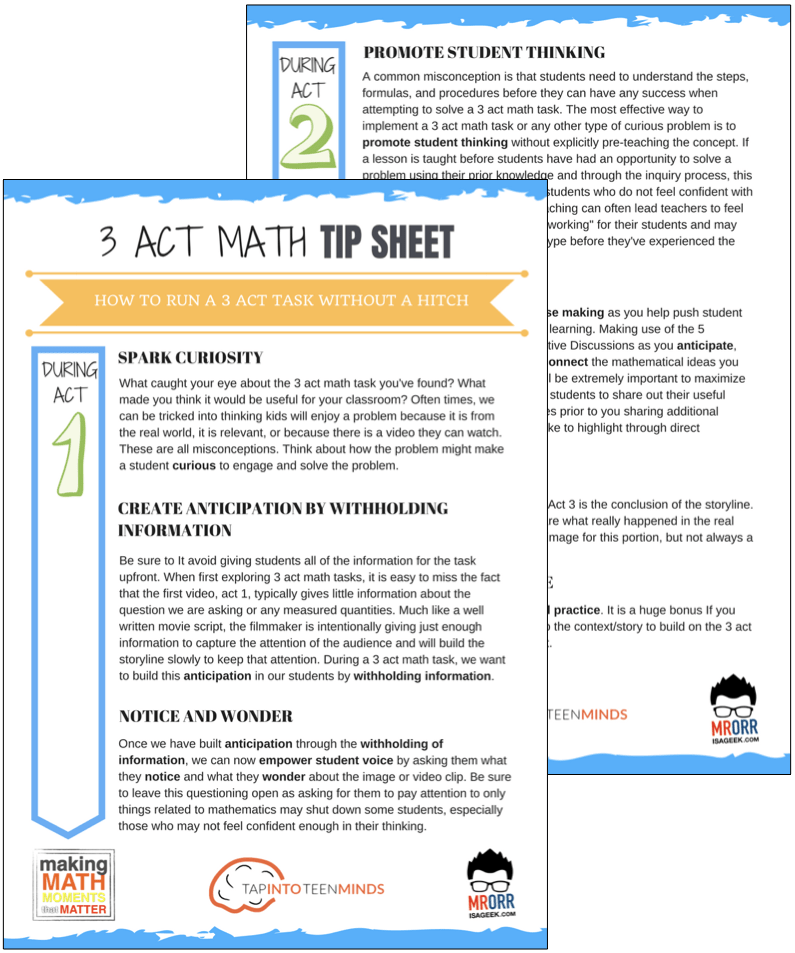
LESSONS TO MAKE MATH MOMENTS
Each lesson consists of:
Each Make Math Moments Problem Based Lesson consists of a Teacher Guide to lead you step-by-step through the planning process to ensure your lesson runs without a hitch!
Each Teacher Guide consists of:
- Intentionality of the lesson;
- A step-by-step walk through of each phase of the lesson;
- Visuals, animations, and videos unpacking big ideas, strategies, and models we intend to emerge during the lesson;
- Sample student approaches to assist in anticipating what your students might do;
- Resources and downloads including Keynote, Powerpoint, Media Files, and Teacher Guide printable PDF; and,
- Much more!
Each Make Math Moments Problem Based Lesson begins with a story, visual, video, or other method to Spark Curiosity through context.
Students will often Notice and Wonder before making an estimate to draw them in and invest in the problem.
After student voice has been heard and acknowledged, we will set students off on a Productive Struggle via a prompt related to the Spark context.
These prompts are given each lesson with the following conditions:
- No calculators are to be used; and,
- Students are to focus on how they can convince their math community that their solution is valid.
Students are left to engage in a productive struggle as the facilitator circulates to observe and engage in conversation as a means of assessing formatively.
The facilitator is instructed through the Teacher Guide on what specific strategies and models could be used to make connections and consolidate the learning from the lesson.
Often times, animations and walk through videos are provided in the Teacher Guide to assist with planning and delivering the consolidation.
A review image, video, or animation is provided as a conclusion to the task from the lesson.
While this might feel like a natural ending to the context students have been exploring, it is just the beginning as we look to leverage this context via extensions and additional lessons to dig deeper.
At the end of each lesson, consolidation prompts and/or extensions are crafted for students to purposefully practice and demonstrate their current understanding.
Facilitators are encouraged to collect these consolidation prompts as a means to engage in the assessment process and inform next moves for instruction.
In multi-day units of study, Math Talks are crafted to help build on the thinking from the previous day and build towards the next step in the developmental progression of the concept(s) we are exploring.
Each Math Talk is constructed as a string of related problems that build with intentionality to emerge specific big ideas, strategies, and mathematical models.
Make Math Moments Problem Based Lessons and Day 1 Teacher Guides are openly available for you to leverage and use with your students without becoming a Make Math Moments Academy Member.
Use our OPEN ACCESS multi-day problem based units!
Make Math Moments Problem Based Lessons and Day 1 Teacher Guides are openly available for you to leverage and use with your students without becoming a Make Math Moments Academy Member.
Partitive Division Resulting in a Fraction
Equivalence and Algebraic Substitution
Represent Categorical Data & Explore Mean
Downloadable resources including blackline masters, handouts, printable Tips Sheets, slide shows, and media files do require a Make Math Moments Academy Membership.
ONLINE WORKSHOP REGISTRATION
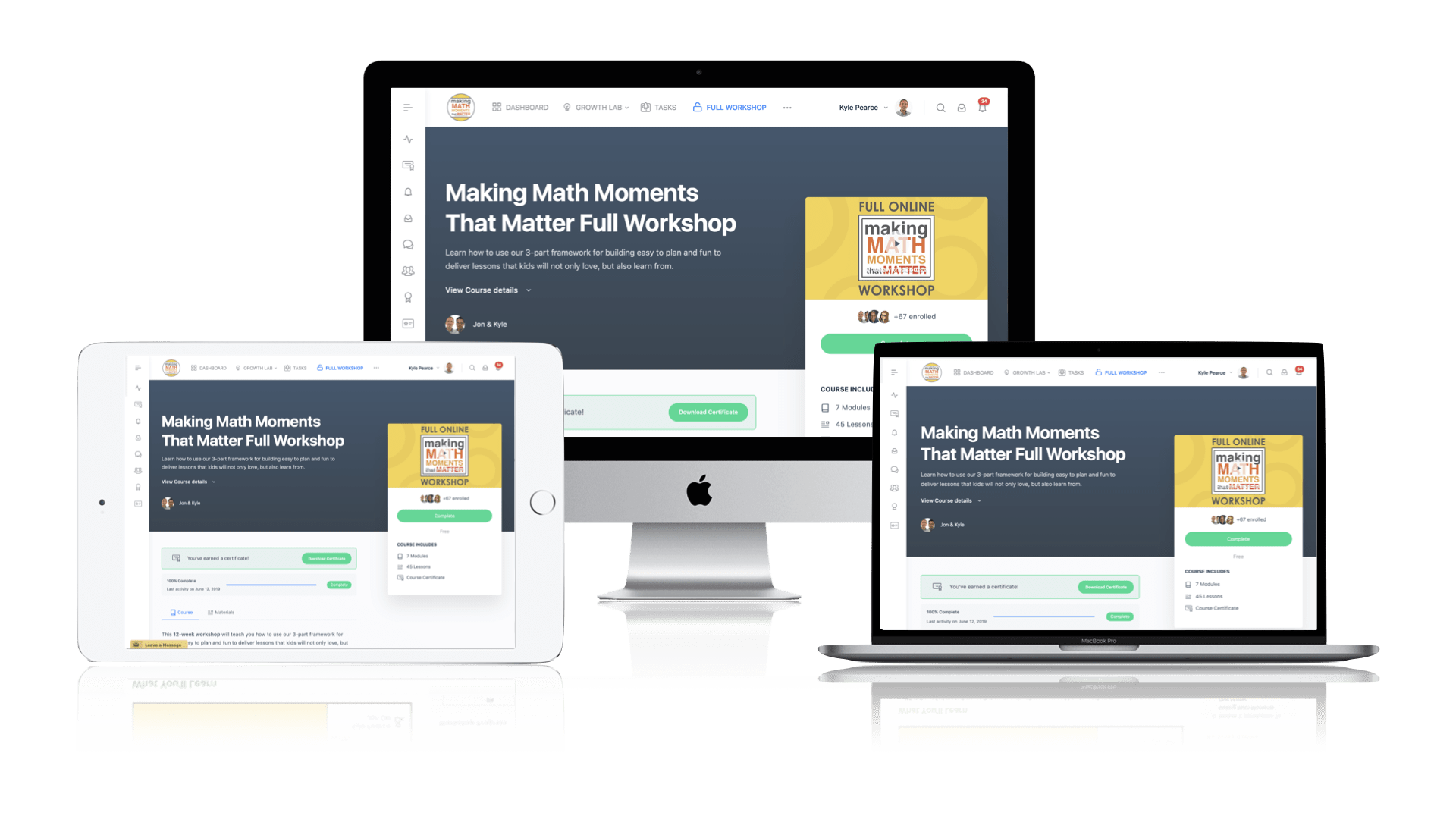
Pedagogically aligned for teachers of K through Grade 12 with content specific examples from Grades 3 through Grade 10.
In our self-paced, 12-week Online Workshop, you'll learn how to craft new and transform your current lessons to Spark Curiosity, Fuel Sense Making, and Ignite Your Teacher Moves to promote resilient problem solvers.
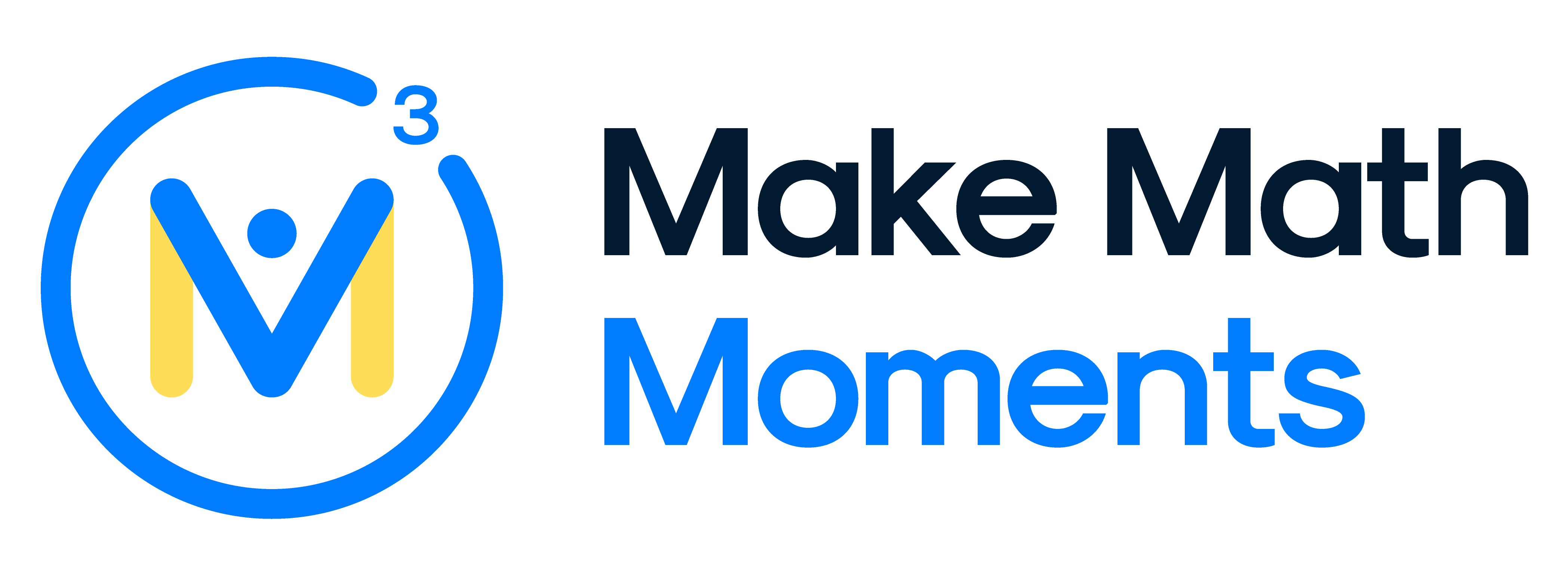



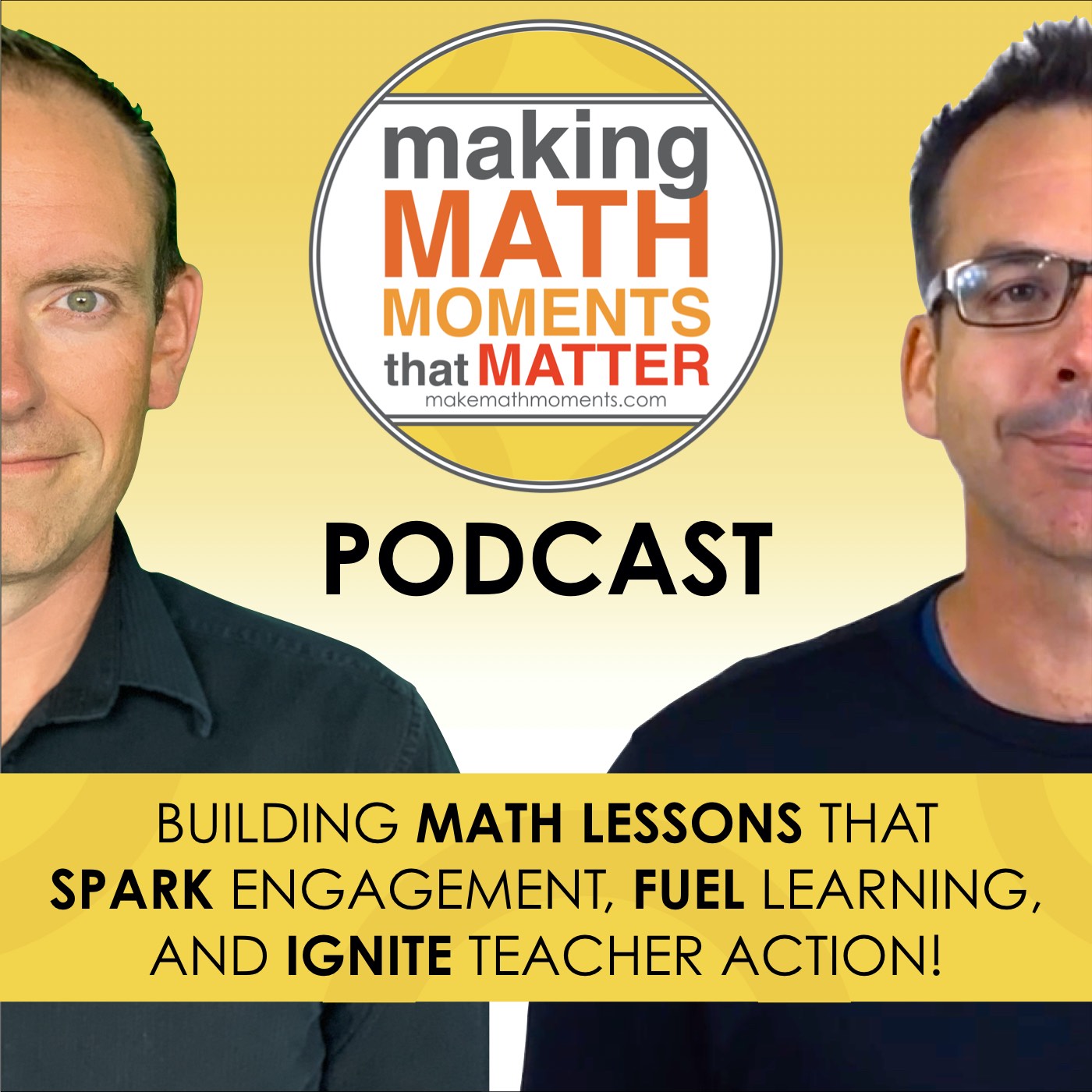
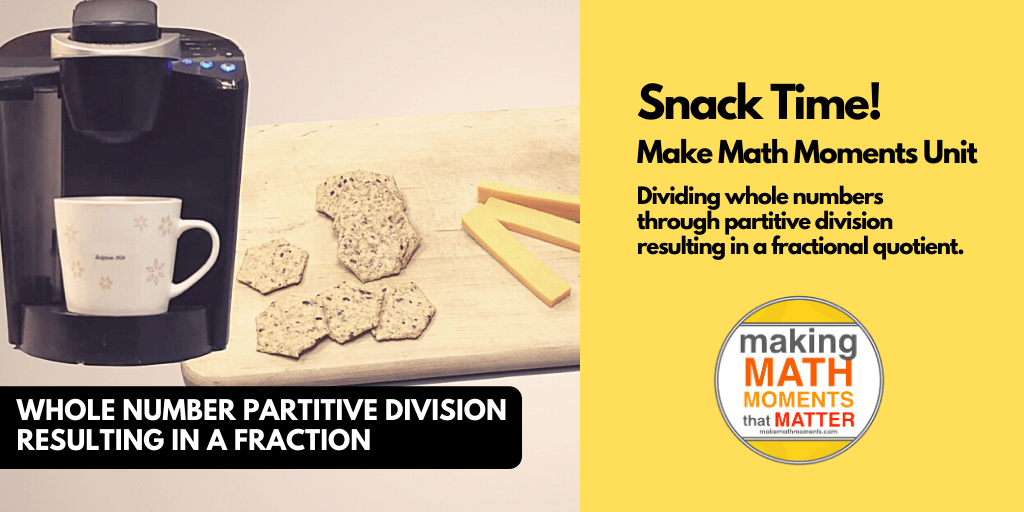

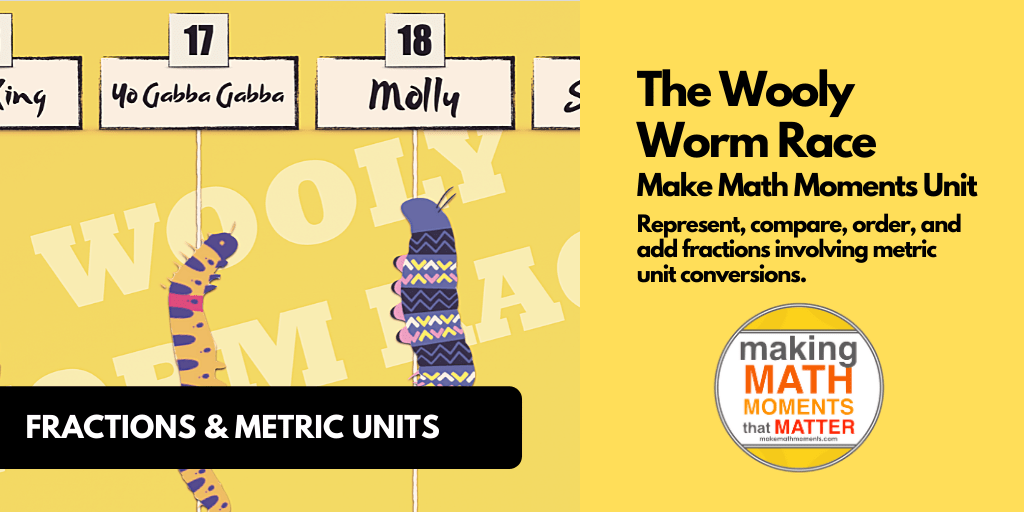
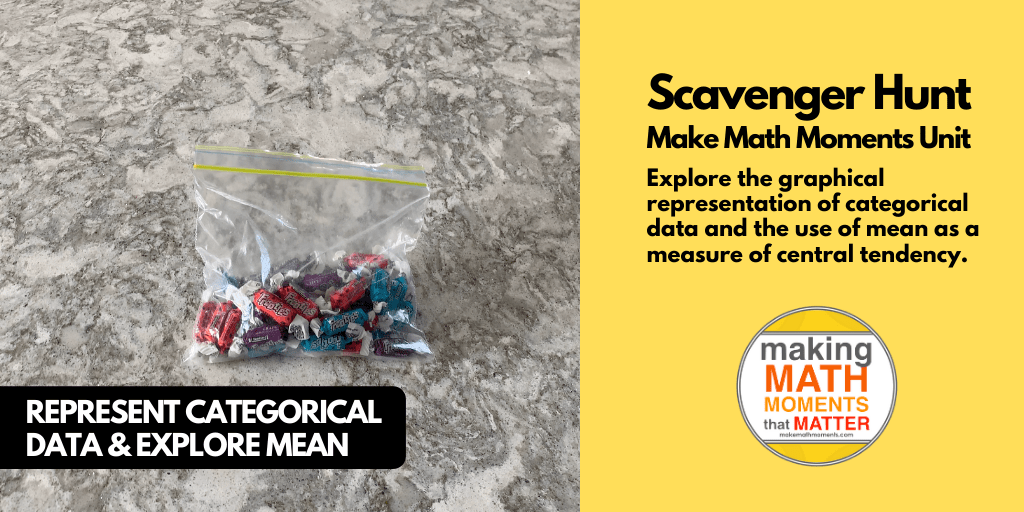
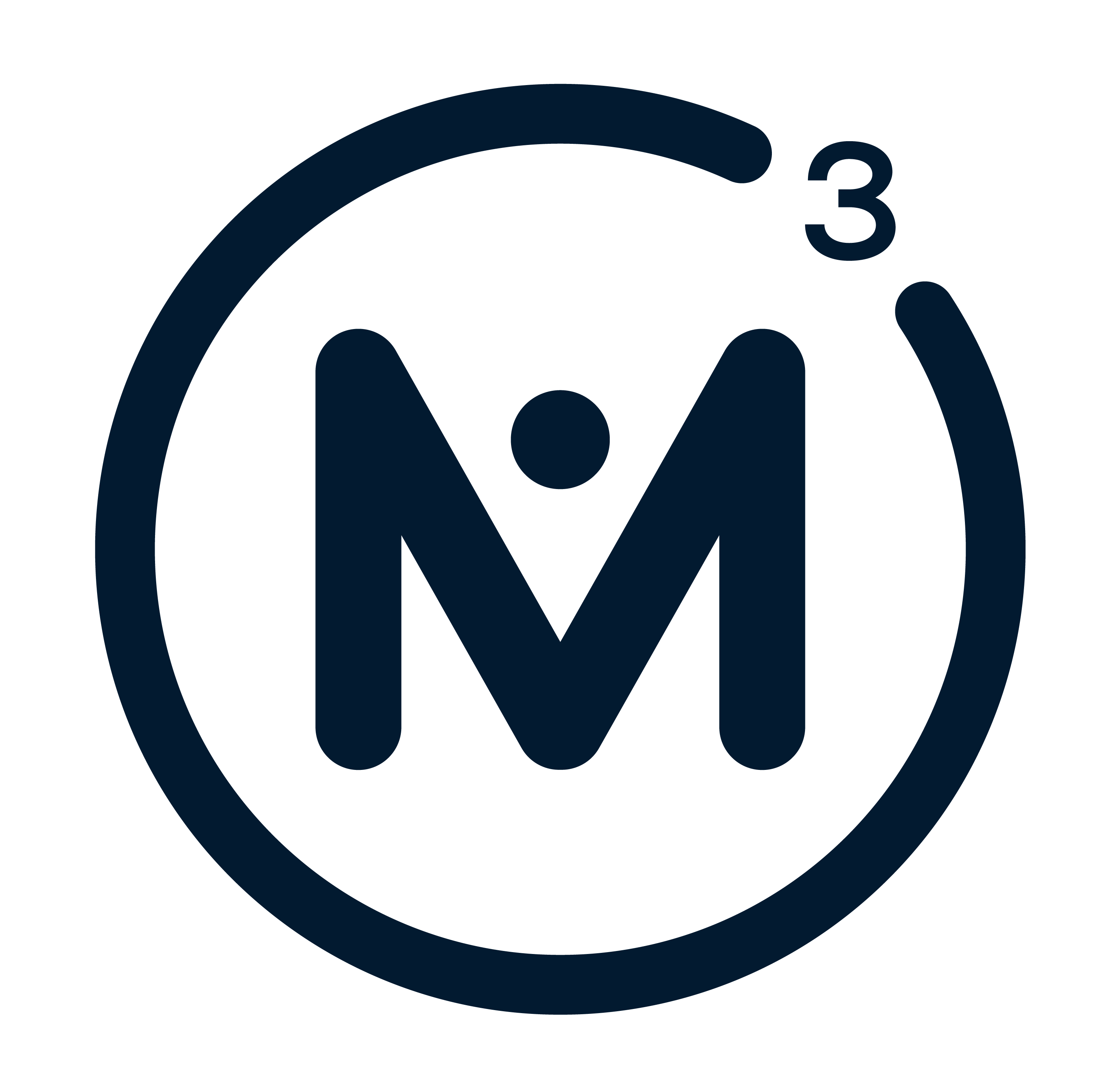
0 Comments